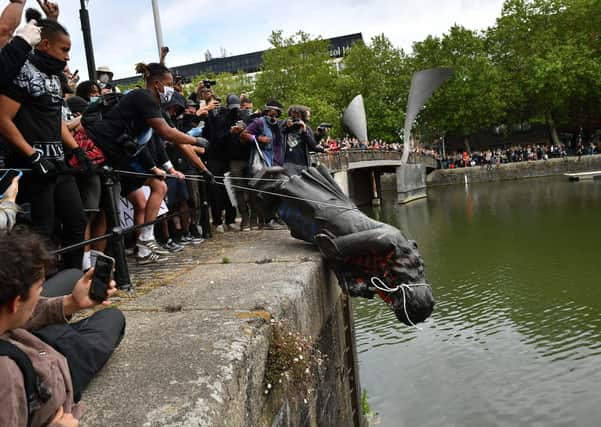George Floyd protests must remain peaceful – leader comment


The people protesting against the killing of George Floyd and racism in America, the UK and the wider world have justice – in the truest sense of the word – on their side.
It is important for everyone to recognise this because it is clear that Western society has a problem which must be addressed. But the protesters need to recognise this too. Following violence by a minority of protesters, Paulette Simpson, the director of the Voice, one of the UK’s leading black newspapers, said she realised some people were “angry”, “in pain” and that they felt “there’s no other route to express yourself”, but she urged them to contain their emotions and made an appeal for restraint. And she is absolutely right.
Advertisement
Hide AdAdvertisement
Hide AdIt is counter-productive to protest violence – in Floyd’s case, deadly violence by at least one police officer – by resorting to violence.
Similarly, it was wrong for the statues of historic figures associated with slavery to be vandalised and, in one case in Bristol, torn down completely. The bronze statue of 17th-century slave trader Edward Colston should have been removed long ago, perhaps to a museum of slavery to enable it to be seen in the proper context that explained just how evil and inhumane his actions were. But such decisions need to be made in an orderly, democratic way – not by a mob.
One reason is that not all decisions are as cut and dried. Henry Dundas’ statue in Edinburgh is a case in point. A controversial figure in the late 18th and early 19th century, known as the ‘Great Tyrant’ and the ‘Uncrowned King of Scotland, he supported William Wilberforce’s bill to end the slave trade in 1792, but put forward an amendment to delay abolition by 15 years. This led to a further 630,000 people being forced into chains, which Prime Minister William Pitt described as an “enormous evil”.
However Dundas did also represent a slave, Joseph Knight, as a lawyer. Knight was brought from Jamaica to Scotland by his ‘owner’ but then filed a legal claim for his freedom with the Court of Session ruling in his favour.
Historian Sir Geoff Palmer has called for a plaque on Dundas’s statue to make clear the appalling effects of his appeasement of the slavery lobby, which seems the least that should be done.
While statues are quite literally set in stone and it is not practical or sensible to constantly change them, we should not be bound for ever more to revere the heroes of the past, particularly if their actions are now considered immoral. They should not be destroyed but we should be open to the idea of relocation, based on reasoned arguments and a proper process.
Apart from the racist past of some historic figures immortalised in stone, another problem is that city centre statues are almost all of men. Many were erected at a time when bigoted views about women were common. And yet young girls walking around our cities today are being repeatedly confronted by the insidious myth that, with a few exceptions, it is men who are worthy of being placed on a pedestal. So if some statues were to be taken to less prominent locations, the resulting spaces could be used to good effect. And perhaps it might be fitting to consider a statue to Joseph Knight, who in 1778 won a landmark ruling – 29 years before the slave trade was abolished – that slavery was not recognised by Scots law.
A message from the Editor:
Thank you for reading this article on our website. While I have your attention, I also have an important request to make of you.
Advertisement
Hide AdAdvertisement
Hide AdWith the coronavirus lockdown having a major impact on many of our advertisers - and consequently the revenue we receive - we are more reliant than ever on you taking out a digital subscription.
Subscribe to scotsman.com and enjoy unlimited access to Scottish news and information online and on our app. With a digital subscription, you can read more than 5 articles, see fewer ads, enjoy faster load times, and get access to exclusive newsletters and content. Visit www.scotsman.com/subscriptions now to sign up.
Our journalism costs money and we rely on advertising, print and digital revenues to help to support them. By supporting us, we are able to support you in providing trusted, fact-checked content for this website.
Joy Yates
Editorial Director